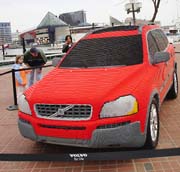 |
||
|
||
Riding with the Volvo Ocean RaceLed by ABN AMRO ONE, the fleet sailed up our Bay into Baltimoreby Kat BennettWith shredded sails and weary bodies, the Volvo Round the World racers completed Leg 5 on Monday, April 17 — but not before Chesapeake Bay had its fun. Thunderstorms and squalls blew ABN AMRO ONE and Movistar in a day early. As they passed Thomas Point Lighthouse, the Bay played a game it loves to use on Annapolis racers. Just as the racers could almost taste Baltimore, the winds died down, slowing the boats to a painful crawl. As they urged on, inch by inch, the air died completely. ABN AMRO ONE had to throw out her anchor to keep from drifting backward. Movistar was still moving around five knots. When the winds revived, ABN AMRO One scored its fourth first-place finish for 6.5 points, arriving at 2:57:52pm after racing 15 days, 2 hours, 47 minutes and 52 seconds from Brazil. Movistar (pronounced mauve-i-star) took second, solidifying her second place overall with an additional six points. Aided by a roaring 54-knot gust, Pirates of the Caribbean sailed in shortly after 7am Tuesday, April 18, for a solid third place. Brasil1, Ericsson and ABN AMRO TWO in that order all reached Baltimore by 2pm. Forth place was hard fought. The Ericsson Racing Team had a 25-mile lead over Brasil1 yesterday, until an afternoon storm with 52-knot winds ripped the jib. Brasil1 sailed passed just before the mouth of the Bay, taking fourth place by 12 minutes at 9:09am. Ericsson crossed the finish line in fifth place. Dockside, Richard Mason of Ericsson told Bay Weekly what it was like to sail the Chesapeake. “Jeepers, it’s a long Bay,” he said. Brasil1’s Stuart Wilson had two words about the Bay: “Love it.” Points from finishing Leg 5 are added to points earned as each boat entered the Bay. First through the mouth of the Chesapeake, ABN AMRO One grabbed 3.5 points there early Monday morning (April 17) with Movistar steaming behind for 3.0 points and Pirates of the Caribbean taking 2.5 points. Meanwhile, in Volvo City, Baltimore
As the Volvo teams raced up the Chesapeake, in Baltimore the shore crews were racing, too. At each leg’s stop-over, an entire city is created within a span of 15 days. Pavilions highlighting each boat and crew offer merchandise and souvenirs. Dining and rest areas are built for the crews and their families. Pirates of the Caribbean Chef Mark says that his job is “to provide good healthy food for the crews — as much as they want. “We try to contact local suppliers to get fresh meat and produce at a reasonable price,” he added. “We do have a budget.” On land, ocean crews dine in mess tents with their families and shore crews. “Everyone here is a big family,” says Rachel Anning, press director for Pirates. “The captains really appreciate their shore staff. Paul Cayard is great for that; he always sends a little message to let us know that he understands how important we are.” During stop-overs, the sailors rebuild their bodies. Besides feasting on the local bounty of the Bay, each team has access to a complete gym in Baltimore Harbor. As the boats approached, Sam Brovender was busy polishing and readying exercise bikes for Team Movistar. “This is such an extreme sport,” he explained, “the crews need to maintain their fitness.” At the same time, families reunite. As fathers and husbands spend weeks away from land and months away from home, their families travel from port to port to savor a few days before the next leg. “It is a little hard for the children that they are away from home so they miss birthdays and holidays,” said Cabrini Salter, wife of Pirate navigator Jules Salter. “But this is a job for these men, and their families support them.” Leisure is a luxury for anybody involved with the race. In Maryland, Cabrini says, “I would like to get some American clothes, go to a nice mall or department store.” Daniel and Bruno of Brasil1’s shore crew are looking for good local restaurants. “We eat out a lot,” Bruno said. After boats and crews have sweltered, strained and sailed in the toughest conditions of the world, families and shore teams stand ready to repair. |
||
|
|
||
|
© COPYRIGHT 2004 by New Bay Enterprises, Inc. All rights reserved. |
